Today’s LucidTalk poll in the Belfast Telegraph certainly makes interesting reading. Or if you are Gavin Robinson horrifying reading. It says he has lost a quarter of the party’s voters since taking the DUP leadership. How worried should he be?
Before we answer that question let’s look at the poll in detail.
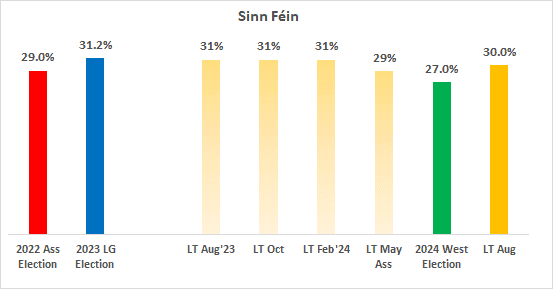
Once again Sinn Féin are the leading party with a support level which has been highly consistent over the last two years. At an Assembly election this would most likely give them between 26 and 28 seats (allowing for the boundary changes probably costing SF their fourth seat in West Belfast). Any more would require either a higher vote share or enormous lashings of luck. This compares to their current 27.
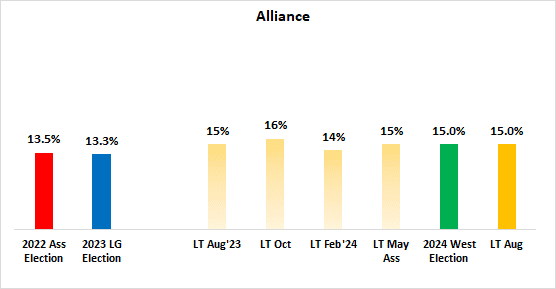

Alliance, too, has had a pretty consistent support level over the last two years. Having won a number of seats by small margins in 2022, a vote at this level would most likely see them on 16 to 18 seats compared to their current 17.


The UUP may have experienced a mini-bounce from their Westminster success in South Antrim. It gives them reason to hope that the worrying vote losses they experienced in some other constituencies could have been a temporary Westminster issue. The poll was taken before Doug Beattie’s resignation was announced. We will have to wait to see whether a new leader moves the dial in either direction.
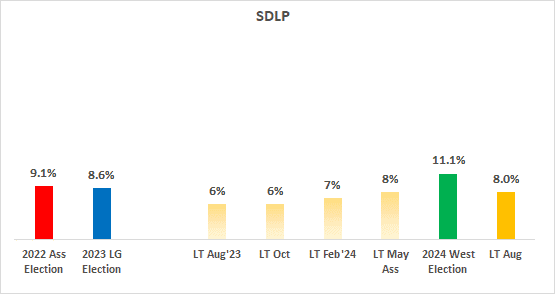

On the one hand, the SDLP’s 8% means “No Change”. But they will be relieved to have the 6%’s and 7%’s behind them. It holds out hope that getting back to their 2022 election share might be possible. They were lucky to get 8 seats last time and would be unlikely to retain them all at 8%. Most likely outcome would be 6 or 7.
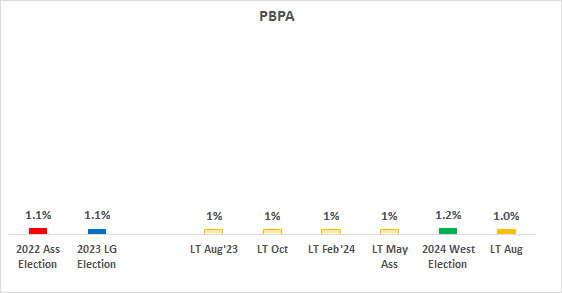

For People Before Profit the most likely result, assuming no change in the geographical distribution or their votes, would be the retention of their current 1 seat.
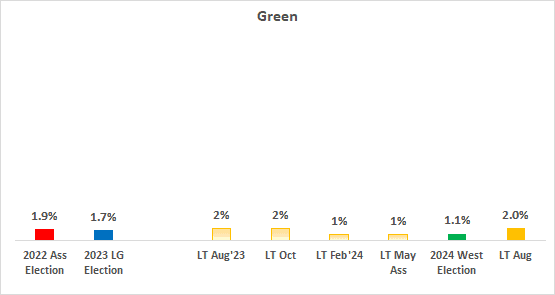

The last time that the Greens won seats, in 2017, they were sitting at 3% and 4% in the LucidTalk polls that year.
Independents
The poll shows 4% for Independents and minor parties. That is the same level as last May. The detailed LucidTalk tables showed 2% of these were for PUP/Conservative/Independent Unionist. 1% for Workers Party/IRSP/Independent nationalists, and 1% for “Neutrals”. We will not know until the tables are published in about a week’s time whether that split is the same this time.
There were two Independents elected at the last Assembly election, both Independent unionists. One, Alex Easton, will not be available this time following his election to Westminster. It is impossible for this poll to measure the support for Claire Sugden individually.
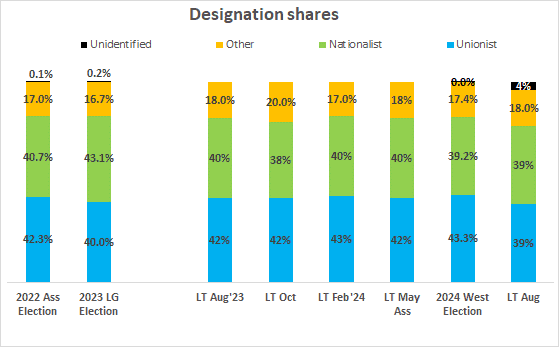

These shares are significant factors in Assembly elections as they are the main influence on the transfers between parties. (For clarity, I include PBP within Other, in line with their designation in the Assembly.) Great caution must be exercised in respect of this latest poll, given that we do not yet have a breakdown for the 4% currently unidentified.
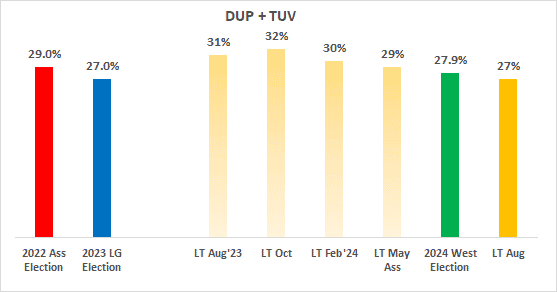

It is helpful to look at the DUP and TUV as a total before examining the individual parties, since the votes in elections largely transfer between them (mostly TUV to DUP) and since support in opinion polls see-saws between them. There is also a lesser relationship with the UUP; for example, the high of 32% last October coincided with a low of 8% for the UUP.
Again, this time the UUP’s 1% increase will have come at the expense of the DUP+TUV total. It is possible that some may have also moved to PUP or Independents.
Were this poll to be repeated in an Assembly election we would expect to see the total number of DUP and TUV seats to be between 25 and 29 (allowing for the likely gain of West Belfast following the boundary changes plus the North Down Assembly seat that Alex Easton gifted the TUV after becoming an MP). This compares with 25 for the DUP and 1 for the TUV at the last election, and 26 for the DUP now. The possibility that the unidentified 4% contains a disproportionate number of unionists, as in LT’s last Assembly poll accounts for the spread of the estimate.)
The next question is how these seats would be divided between them.
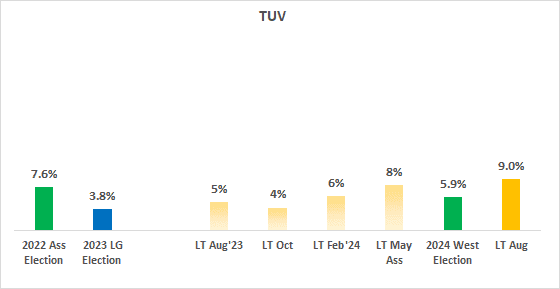

A 9% TUV share would put them into the region where they a likely to start taking seats. Taking the Westminster vote as a guide there are between 4 and 6 constituencies where they might provide a very serious challenge to the DUP. There is great uncertainty on the outcome at this share, anywhere between 2 and 7 could be likely.
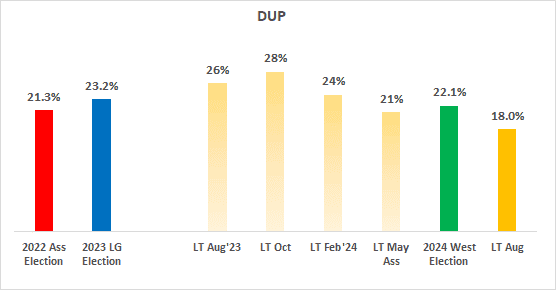

This would leave the DUP most likely seat total between 18 and 24 seats.
The Warning
The headline to this article says beware. That is because we have been here before, and more than once.
Throughout 2021, and into 2022, LucidTalk consistently recorded the TUV in double figures. Indeed in August 2021 the TUV led the DUP, 14% to 13%. In April 2022 they were still on 9%, but in the election the following month took 7.6% and one seat.
In April 2023 the TUV were on 7% in the LucidTalk poll. Again, in the actual election the following month their actual performance was 3.8% (some, but not all, of which was due to leaving District Electoral Areas uncontested.)
In May 2024 at the start of the Westminster election campaign LucidTalk showed the TUV at 8.5% but declining in later polls as the campaign progressed. On the night they emerged with 5.1%, a quarter of which was accounted for by Jim Alister alone.
It looks like some unionist voters use the opinion polls to signal their unhappiness with the post-Brexit arrangements, but that their willingness to actually vote for the TUV wilts as the consequences of their choice become more real as the day of decision approaches.
Best to wait until we see if the TUV support is retained over the coming months.
There is also another way to read this. Before the Westminster vote Jim Alister framed the election in NI as a referendum on the Westminster Agreement and, by implication, the DUP’s decision to return to Stormont. A referendum which he and the TUV resoundingly lost.
Perhaps a section of unhappy unionists have decided that the border checks are not as threatening as they assumed, or that it is time to move on, or have just become more weary of the whole thing. Hence the support for the TUV in a consequence free poll only hits 9%, well below the 14% it achieved at its height.
As ever, time will tell.
Michael Hehir is a retired sales and marketing manager. He studied in Northern Ireland but now lives between England and Italy.
Discover more from Slugger O’Toole
Subscribe to get the latest posts sent to your email.



